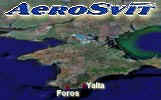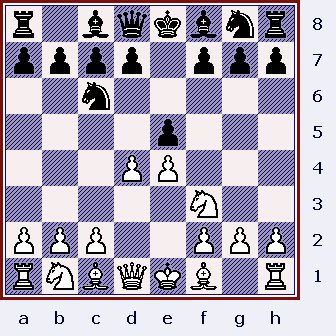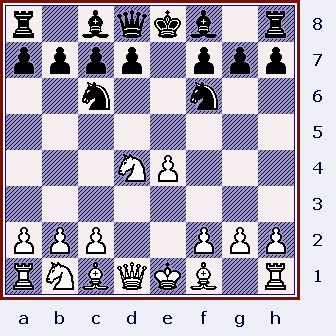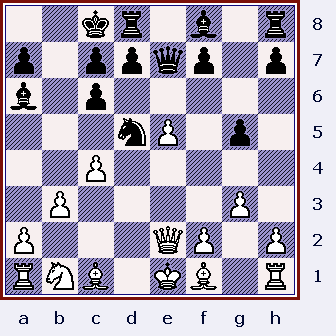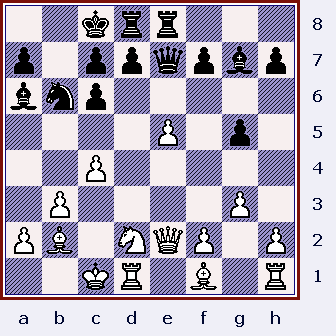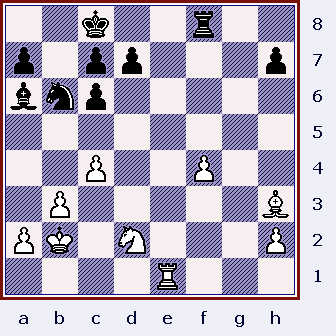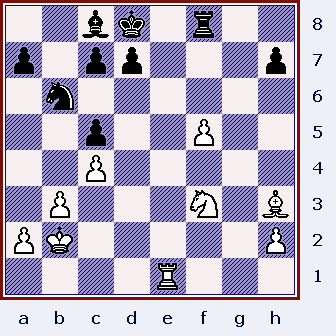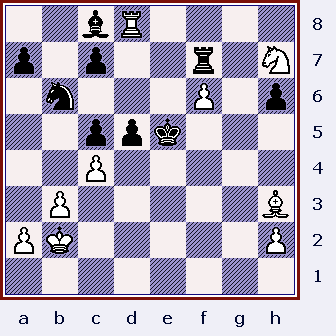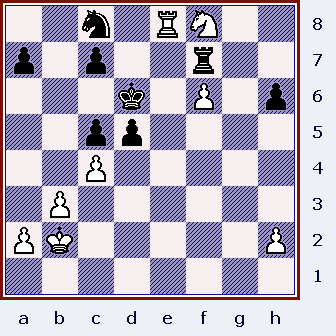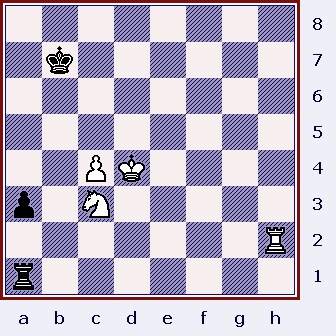GM Sergei Rublevsky (2687) -
GM Ruslan Ponomariov (2738)
[C45]
Aerosvit GM
Foros, UKR; (R
#3) / 19,06,2006.
[A.J. Goldsby I]
My "Game of the Month" for June,
2006. (Cf. TWIC #
606.)
I chose to annotate this game for
many reasons, primarily:
A.) GM Sergei Rublevsky has long been one of my favorite players.
B.) It was one of the highest rated (decisive) games from the most recent issue of TWIC.
C.) I have never featured this particular opening line on my "Game of The Month"
column, so
I figured that it was long overdue.
(The Scotch Game was one of the first openings that I ever seriously studied. And while I never used
this opening in tournament play, I have always been interested in it as a viable opening plan.)
***** ***** ***** ***** ***** *****
***** ***** ***** ***** ***** *****
***** ***** *****
{The ratings are those of
FIDE, and were assigned to this game when it was downloaded from LCC.}
1.e4 e5;
2.Nf3 Nc6;
3.d4, ('!?') {See the diagram given, just
below.}
The Scotch Game. [more]
(A
Wikipedia article
on this opening.)
It used to be you could thumb through an entire issue of the latest Informant, and never see one good game in this opening system. I
once asked a master why this was, and he told me it was "an opening system without any real bite, White prematurely releases all the tension in the center."
r1bqkbnr/pppp1ppp/2n5/4p3/3PP3/5N2/PPP2PPP/RNBQKB1R b
This opening lay virtually dead and unused at the master level for maybe close to 100 years, then Kasparov's use of this opening reawakened GM interest in this hoary system. [See the introduction in MCO-14 for more details.] Today, there is always several good games every year in this particular branch of the opening.
Perhaps one good reason many masters play this opening is to try and avoid the
(over-analyzed?) lines of the "Spanish Torture." {See the game given, just below.}
[ A recent GM example of the Ruy Lopez would be:
3.Bb5 a6; 4.Ba4 Nf6;
5.0-0 Be7; 6.Re1 b5;
7.Bb3 d6; 8.c3 0-0;
9.h3,
The main line.
Now there are many variants that Black can choose from, here GM Vassily
Ivanchuk
chooses the Zaitzev System, first made really popular by GM Anatoly Karpov.
[See MCO-14 for more details.]
9...Bb7; 10.d4 Re8;
11.Nbd2 Bf8; 12.a4!? h6;
13.Bc2 exd4; 14.cxd4 Nb4;
15.Bb1 c5; 16.d5 Nd7;
17.Ra3 f5!?;
All this is 'book theory.'
(See the 20th game of the 35th World Championship Match played between
Kasparov and Karpov in New York/Lyon in 1990.)
18.g4!?,
A relatively little used move, theory considers it to be innocuous.
(The main line is 18.Nh2, according to the CB PowerBook here.)
18...fxg4!?; 19.hxg4 Ne5!?;
Playing the KB to e7 - to prevent White's next move - might have been a little more prudent.
20.g5! Bc8!?; 21.Nxe5 Qxg5+;
22.Rg3 Qxe5; 23.Nf3 Qh5?!;
White has a ton of play for the Pawn, but this could be the losing move. ('?')
[ >/=
23...Qf6; looked like a better idea for
Black. ]
24.Kg2!
Bg4; 25.Rh1 Bxf3+; 26.Rxf3 Qg4+; 27.Kf1
Rxe4;
Fritz considers this best/forced, therefore Black is already busted.
28.Bxh6
Ra7; 29.Bd2 Rf7; 30.Bxe4 Qxe4; 31.Rfh3
Rf5;
32.Bxb4 Qxb4; 33.Qe2 Qc4;
This is practically forced, of course not 33...QxP/a4??; 34.Qe6+, and mate next move.
The rest requires little comment.
34.Qxc4 bxc4;
35.Rh5 Rxh5; 36.Rxh5 Be7; 37.Rh3! Bf6; 38.b3! c3[];
39.Ke2 Kf7;
40.Kd3 Kg6;
41.Rh8 Kf5;
42.Ra8 Ke5; 43.Rxa6 Kxd5;
44.a5 g6; 45.Ra7 Kc6;
46.Rf7,
("+/-") and Black finally gave up the struggle at this point.
GM Ruslan Kasimdzhanov (2673) - GM Vassily Ivanchuk (2731);
[C92]
The 37th FIDE (men's)
Olympiad /
Turin, ITA; (R #4) /
24,05,2006. [replay]
A fine win by the {former} FIDE World Champion, but to be fair to Ivanchuk, much of this
might have been prepared in advance. ]
3...exd4; 4.Nxd4 Nf6;
One of the most critical and topical of all the lines that are played today.
r1bqkb1r/pppp1ppp/2n2n2/8/3NP3/8/PPP2PPP/RNBQKB1R w
Of course Black hits the center and also develops a piece ...
so there should be nothing fundamentally wrong with this variation for Black.
[ The "old main line" would probably have to be:
4...Bc5;
5.Be3 Qf6;
6.c3 Nge7; 7.Bc4!?,
"+/="
with good play for White ... the first player has many impressive wins
in the database from the position after 7.Bc4.
Perhaps one of the highest-rated examples (that I was able to find
in the database) would have to be:
GM Garry Kasparov (2780) - GM Nigel Short (2685);
ICT, 10th Super-GM (Inv.) /
Round # 8 /
Linares, ESP; 1992.
{White won a wild game, 1-0 in 48 complicated moves.} [replay]
[ See MCO-14, page # 107; columns # 13 and # 14, and all relevant notes. ]
Another
recent example of this opening would be:
GM H. Nakamura - GM N. Mitkov; /
The North American Open
Las Vegas, Nevada;
(USA) / 2005.
/ 1-0 in 49 moves. [replay]
{White won a good game, Black actually transposed his fourth and fifth moves.
See page 12 of the April 2006 issue of "Chess Life" for more details. And as
far as I can determine, this game is not in the CB
on-line database.}
**********************************************************************************************
For an analysis of the move of:
4...Qh4;
( Move by - Wilhelm Steinitz
) ...
... see my web page on the
contest:
T. Oral - M.
Kantorik;
2000. ]
5.Nxc6!?, (Hmmm.)
One of the sharper lines ...
This is an old continuation, a book, (published in the early 1970's); labeled it as simply inferior. However, since Garry took it up, it has become one of the main lines of this whole opening system.
See MCO-14 for more details, and see also the super contest:
GM G. Kasparov - GM A. Karpov; /
The (FIDE) World Championships (match)
/ New York (USA) & Lyon (France), 1990.
(1-0) [replay]
{In game # 16, Kasparov won, but it took him over 100 moves to do so!}
[ An older - but very solid line - of this opening system would be:
5.Nc3
Bb4; 6.Nxc6 bxc6; 7.Bd3 d5; 8.exd5 cxd5;
9.0-0 0-0;
10.Bg5
c6; 11.Qf3 Be7;
So far, this is all book.
[ See MCO-14, page # 102; column # 01, and all notes. ]
12.h3, "~"
("+/=")
White has a slight edge here, although neither side holds the upper
hand - in terms of results - from this position.
GM D. Pavasovic
(2502) - GM A. Beliavsky
(2650); [C47] [replay]
13th Vidmar Memorial Tournament
/ Portoroz, SLO;
(R# 10) / 23,06,1999.
(White had an advantage out of the opening, but Black went on to ...
{eventually} ... win this one.) ]
Now - for the next few moves - we follow a 'book' path.
5...bxc6; 6.e5 Qe7;
7.Qe2 Nd5; 8.c4 Ba6;
9.b3 0-0-0; ('!?' - Maybe - !)
One of the more popular lines that is being played today. (It is also very old, and was
first seen in a match
between Blackburne and Zukertort, in 1881; at least according to the database.)
[ Black can also play the seemingly wacky move of ...g7-g5;
here in this position.
(It leads to enormous complications.)
For example:
9...g5!?;
10.Ba3 d6; 11.exd6 Qxe2+; 12.Bxe2 Bg7;
The end of the column.
13.cxd5
Bxe2; 14.Kxe2 Bxa1;
("~" / Unclear?)
The authors of MCO consider the chances from this position to be roughly equal,
this is all based on the following contest:
GM Garry Kasparov (2795) - GM Viswanathan Anand (2725);
The PCA World Champ. Match /
New York, NY-USA; (G8); 1995.
[replay]
(This game resolved itself as a draw by repetition {½-½} after 22 tension-filled moves.)
[ See MCO-14, page # 105; column # 07, and all the notes that correspond to this column,
especially note # (h.) here. ] ]
10.g3 g5;
{See the diagram - just below.}
Black seeks to prevent his opponent from getting in (an easy) f2-f4, which bolsters the
beleaguered White King-Pawn.
2kr1b1r/p1ppqp1p/b1p5/3nP1p1/2P5/1P4P1/P3QP1P/RNB1KB1R w
We have reached a position where nothing has been resolved, and a great deal of tension still exists.
[ Also possible is:
10...Re8;
11.Bb2 f6; 12.Qd2 Nb6; 13.a4, "~"
[ See MCO-14, page # 105; column # 07, and note # (f.). ] ]
11.Bb2 Bg7; 12.Nd2 Rhe8;
This looks fine, 12...Nb4; is also a stern test of White's opening.
13.0-0-0 Nb6; (A prep. idea?) {See the diagram given -
just below.}
Black removes his Knight from the d5-square, perhaps with the idea of winning the White KP.
2krr3/p1ppqpbp/bnp5/4P1p1/2P5/1P4P1/PB1NQP1P/2KR1B1R w
Of course not 13...BxP/e5??; 14.BxB, QxB; 15.QxQ, RxQ; as now, since there is no pin along the a6-f1 diagonal, the first player is free to capture the Black Knight on d5 (with the c4-pawn), winning material.
[ Also interesting was:
13...Qc5!?; with an unusual position.
]
14.f4 gxf4!?;
15.gxf4 f6!?;
(Maybe - '?!')
Black wishes to immediately resolve the question about the center, but I am not sure if this was the best way of going about this.
[ Maybe the continuation of:
(>/=)
15...Bb7; 16.Rg1,
"+/=" would have made more sense
for Black - than the continuation played here in the actual game.
]
16.exf6! Bxf6[];
('Box.')
This is probably forced for Black.
[ </=
16...Qxe2?; 17.Bxe2 Bh8;
18.Bh5 Rf8; 19.f7, "+/" or "+/-"
]
17.Qxe7 Bxb2+;
Without this saving check, Black's position would have become untenable rather quickly.
18.Kxb2 Rxe7;
19.Bh3!?N,
Is this the best that White has?
(I am not at all sure about this, 19.a4! was my first impulse when I played over this game. Of course, I was under
no pressure, and no clock was ticking away, either.)
[ Certainly the natural move of
19.f5,
"+/=" looked promising here.
********************************************************************************
Also probably better than the game would have been:
(>/=)
19.a4!, "+/="
{Diagram?}
when the first player may yet hold some small advantage out of this position.
GM J. Hector - GM J.
Timman; / ICT, Masters /
Sigeman &
Company
/ Malmo, SWE; 2001.
(0-1)
{White went astray and later lost this key contest in 40 moves.}
]
19...Rf8; 20.Rhe1!?,
I don't know about this, now f4-f5 looked like the only move for White to maintain an advantage here.
[ Almost certainly better was:
(>/=)
20.f5 Re3; 21.Bg4 h5;
22.Bxh5 Rxf5; 23.Bg4 Rf2; 24.Kc1,
"+/="
with some advantage for White. ]
20...Rxe1;
21.Rxe1, {See
the diagram given - just below.}
The middlegame has now evolved into a complex ending - Rublevsky hopes that Black's off-side Bishop and Knight will turn into a tangible advantage for him.
2k2r2/p1pp3p/bnp5/8/2P2P2/1P5B/PK1N3P/4R3 b
But in view of the Pawn structure, it is not all that easy for White to make something out of this position.
Black to move in this position.
21...Kd8?!; (Maybe - '?')
Live or die, it seemed that Black had to capture on f4 here, although it is clear that Black's King may not be completely happy about this particular decision. (See the note given - just below.)
[ The critical thread might be:
>/= 21...Rxf4; ('!')
22.Re8+ Kb7;
23.Ne4 d6[]; 24.a4 Rh4!;
25.Bf5 Rxh2+;
26.Kc3 Bxc4!;
27.bxc4 Nxa4+; 28.Kb3 Nb2;
"~" when Black ...
who has four Pawns for a minor piece ... seems to be in no danger of losing
this argument. ]
22.f5 Bc8;
23.Nf3 c5; {See
the diagram given - just below here.}
Now Black is barely hanging on in this position.
2bk1r2/p1pp3p/1n6/2p2P2/2P5/1P3N1B/PK5P/4R3 w
Of course - if you take a look here - it should be easy to decide which side of this chessical brawl that you would want to be on now.
[
</= 23...d5?!;
24.Nd4!, '±'
]
White continues to pursue his initiative from here. (25.Ne5 looked good for White as well.)
24.Rg1 d5; 25.Ng5!? h6;
26.Nh7 Rf7?;
This is probably the decisive mistake for White in this contest.
[ >/=
26...Rh8[]; 27.Rg7, "+/="
27...dxc4;
"<=>" ]
27.Rg8+ Ke7;
28.f6+ Kd6;
29.Rd8+ Ke5; {See the diagram ... just below.}
Black is struggling here, and I doubt that it makes much difference what move Ivanchuk chooses.
2bR4/p1p2r1N/1n3P1p/2ppk3/2P5/1P5B/PK5P/8 w
Notice how Black is about to lose a piece from this position.
[ Or
29...Bd7!?; 30.Bf5 Ke5; 31.Bg6
Rxf6; 32.Nxf6 Kxf6; 33.Bd3, "+/-"
& White is winning.
****************************************************************************************************************
Another way for
the second player to lose would be:
(</=) 29...Kc6!?;
30.cxd5+ Nxd5; 31.Bxc8 Rxh7!?; 32.Bf5 Rf7;
33.Be6, "+/-"
... and the Bishop fork will cost Black a piece here. ]
30.Re8+ Kd6; 31.Bxc8 Nxc8;
32.Nf8!, (Did he miss this?)
{See
the diagram given below.}
Now Black is clearly lost.
2n1RN2/p1p2r2/3k1P1p/2pp4/2P5/1P6/PK5P/8 b
One point is that if Black tries to save his hanging Knight, then the answer to
32...Nb6?? is 33.Re6#.
[ After the continuation of: </=
32.Rxc8 Rxh7; 33.Rd8+ Ke6; 34.Rxd5 Kxf6; 35.Rxc5,
'±' {D?}
White is clearly (much) better, but perhaps Black has some slim chances to draw this position.
]
Now Black is lost ... and the rest does not require a lot of comment from this annotator. (However, I would advise
close and careful study of Rublevsky's technique, a lesser master would have only drawn this endgame. The way in which White centralizes his King, and then coordinates the play of his Rook and Knight is both lovely and highly instructive.)
32...Rxf6;
33.Rxc8 dxc4;
34.bxc4 Rf2+; 35.Kb3 Rf3+;
36.Kc2!? Rf2+; 37.Kd3 Rf3+;
38.Kd2 Rf2+;
39.Ke3 Rxh2;
40.Re8! c6; 41.Re6+ Kc7;
42.Ng6 Rxa2; 43.Ne5 h5;
44.Rxc6+ Kb7; 45.Rxc5 h4;
46.Nf3 h3;
47.Rh5 Ra3+;
48.Ke4 Rc3; 49.Nd2! Ra3;
50.Kd4 a5; 51.Ne4 a4;
52.Nc3 Ra1;
53.Rxh3 a3;
54.Rh2, "+/-" {See
the final diagram ... the one given just below.}
Since it is clear that Black cannot advance his QRP without losing it, this was an appropriate time to give up the fight.
8/1k6/8/8/2PK4/p1N5/7R/r7 b
A magnificent game by Rublevsky, but (as always); the loser missed many chances to offer a better and more sturdy defense. (GM
Mikhail Golubev gives brief
notes to this game.)
Copyright (c) A.J. Goldsby, 2006. All rights reserved.
1 - 0
The analysis for
this page was prepared with the excellent programs,
ChessBase
8.0 and ChessBase
9.0.
The HTML was
polished with several different tools and programs, (mostly
FP) ... the text was checked for spelling
with MS Word.
The diagrams
were created with the program, Chess
Captor 2.25.
Further study:
-
Please see game
three of the (first)
Kramnik vs. Deep Fritz match. (This game
on the CG server.)
-
GM Yasser Seirawan annotates
a contest ... where GM Garry Kasparov
uses the Scotch Game.
-
My
page ... on
a Scotch Game ... with some
emphasis on the general theory of the opening.
-
I have not {yet} had the time to analyze THIS
GAME in detail, however GM S. Rublevsky - once
again -
shows
that he is perhaps the world's leading practitioner of the Scotch
Game. (He wins a nice effort.)
|

